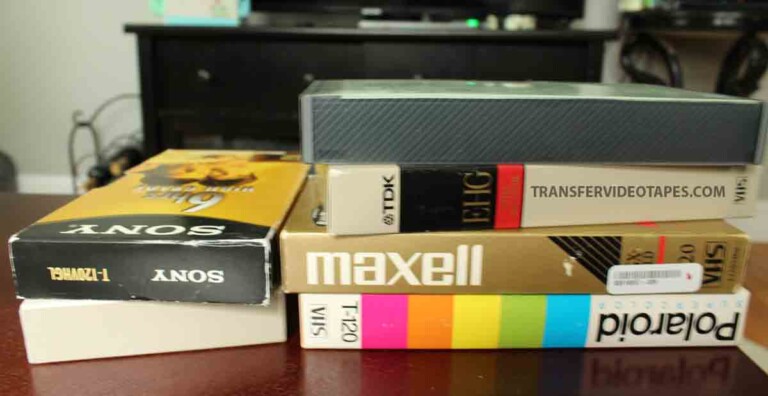If you were lucky enough to grow up in the 1970s or ’80s you will certainly remember nearly every household had a VCR, and renting movies from the video store to watch in your own home seemed too good to be true.
The movies you rented weren’t streamed, there was no Netflix or YouTube. Instead, movies and video was stored on one of a few popular videotape formats like VHS or Betamax.
And if you wanted to watch a live TV show after it aired you needed to “tape it” with your VCR, meaning record the show onto magnetic tape so you could watch it at a later time.
If this all sounds like a foreign world, or perhaps a distinct memory then keep reading as this article will re-acquaint you with the different consumer-grade videotape formats that exist, and may help you identify the types of tapes you found in your closet and hopefully want to restore.
Common Features of VideoTape Formats
All video tape formats came in some sort of cassette that holds the tape and allows it to be played, rewound, and fast-forward. To find a particular scene you had to scan through the entire tape to find it. There were no chapters or thumbnails. It was linear video and patience at its finest.
Remember having to rewind your VHS tapes before you returned them to the video store otherwise, you’d get charged extra?
All of the home movies and tapes you recorded or rented were stored on various types of magnetic videotape. All of these formats improved in quality over the years moving from analog formats eventually to digital shortly before they became obsolete along with BlockBuster video.
Complete List of Consumer Grade VideoTape Formats With Pictures
Below is the complete list of consumer-grade video tape formats in somewhat chronological order. By going in this order you can see the evolution of the tape formats
Betamax
Betamax is best known for being the format that was the main competitor to VHS as home video tape systems became popular. It was developed by Sony and released in 1975, prior to the release of VHS.
Betamax had a higher resolution than VHS and a smaller cassette size but eventually lost out to VHS in the format wars partly due to its shorter tape length.
VHS (Video Home System)
VHS was the king of all videotape formats, or at least the most common format that was found in nearly every household. It was developed by JVC in 1976 It rose to dominance in the early 1980s when affordable tape players were sold in electronic stores like Lechmere, and every town had a Blockbuster or other VHS rental store.
VHS wasn’t necessarily the best-quality video format of its time, but it beat out Betamax and absolutely dominated the market during the 1980s.
VHS-C
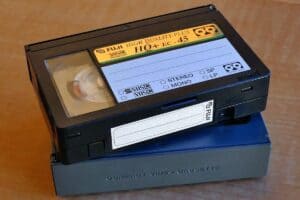
VHS-C was introduced in 1982 to solve the problem of average consumers needing huge camcorders that could fit a full-sized VHS tape.
The VHS-C cassette contains the same videotape that was in a regular VHS cassette but held in a smaller cassette that could later be put into an adapter and played on a home VHS tape player. This meant smaller more user-friendly camcorders for the end-users.
The main drawback of VHS-C was the shorter tape length, only 30 minutes when recorded at SP mode.
Video8 / 8mm
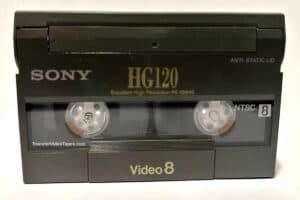
The Video8 or 8mm tape format was launched in 1984 as a direct competitor to VHS-C.
Video8 had roughly the same video quality but higher audio quality than the VHS formats. Its much smaller tape size also meant the camcorders that used 8mm were designed to be smaller as well, giving way to the term “palmcorder”.
The main drawback of the Video8 format is that the tape could not be played back on a home VHS player, Video8 camcorders had to be connected to a TV or VCR with cables to view the footage.
S-VHS / Super VHS
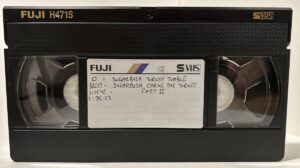
S-VHS or Super VHS video tape format was launched in 1987 as a higher quality version of VHS. With improved luminance picture detail to 400 lines of resolution, compared to VHS’s 240 lines of resolution.
The tape size and width were identical to VHS so that it can be easily confused with “regular” VHS. The main drawback is tapes recorded at S-VHS quality could not be played back on a “regular” VHS player correctly.
Despite the higher quality S-VHS never became as popular as VHS and was generally sought out by “prosumer” videographers.
Hi8
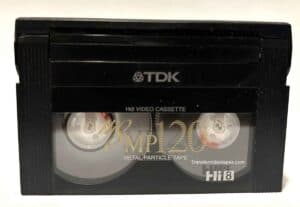
The Hi8 format was the 2nd generation format in the 8mm family using the same size tape format as Video8.
Hi8 was a direct response to S-VHS that was released by Sony in 1989. Like S-VHS, the Hi8 format could record at 400 lines of resolution.
Hi8 camcorders were also backward compatible with the Video8 format, which meant they could play back tapes originally recorded in Video8 format.
Hi8 not only was popular among consumers but also in the airline industry as well, with its compact size and ability to hold 2 hours or more of video the movies you watched on many flights were most likely stored on a Hi8 tape.
MiniDV

MiniDV and the DV codec were developed in 1995 by Sony and Panasonic. It was the first consumer-grade tape format to store video in a digital format. It peaked in the early 2000s in popularity before eventually giving way to camcorders that stored video on hard drives and removable media.
The DV codec stored higher-quality video than its analog predecessors at 480 lines of resolution and higher audio quality. It also captured the exact timecode onto the tape, meaning the time and frame # plus the date and time it was recorded was captured for each frame.
MiniDV was also a very compact size video tape, far smaller than other formats. There were some variants of MiniDV that followed like DVCPRO.
Eventually, HD-quality video known as HDV was also engineered to work with MiniDV tapes, but the format didn’t last long as hard drives and removable media became the next choice for storing HD-quality video,
For more information on the MiniDV format see our MiniDV FAQ page.
Digital8
Digital8 was the 3rd generation in the 8mm video format that was introduced in 1989 by Sony. This was the first digital format in the Video 8 series where video was stored in pure digital format using the DV codec (think 1s and 0s) vs an analog format.
The main benefit of Digital8 was improved video and audio quality, plus backward compatibility with playing Video8 and Hi8 tapes on most camcorders.
The only drawback of Digital8 was in order to store more information on the videotapes the speed was increased, meaning a videotape that would record 2 hours of Hi8 video would only record 1 hour of Digital8 video.
U-Matic
U-Matic was really the first consumer-grade video format that came out in the early 1970s but failed to gain much attention which is probably why you have never heard of it.
This format became more popular with broadcast television stations than consumers, the VCRs themselves were quite large and not very portable.
Converting Your VideoTape Formats to Digital
Hopefully, you find this list of videotape formats helpful and can correctly identify any tapes you may own.
The next ideal step is to convert your videotapes to a digital format as all tape formats degrade over time and eventually become unplayable. Please view the content on this site and see if you find any articles helpful.

